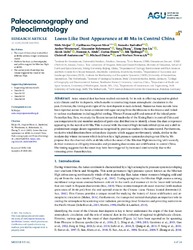Loess‐Like Dust Appearance at 40 Ma in Central China
Dupont‐Nivet, Guillaume
Woutersen, Amber
Zhang, Yang
Liu, Xiang‐Jun
Abels, Hemmo A.
Meijer, Niels; Dupont‐Nivet, Guillaume; Barbolini, Natasha; Woutersen, Amber; Rohrmann, Alexander; Zhang, Yang; Liu, Xiang‐Jun; Licht, Alexis; Abels, Hemmo A.; Hoorn, Carina; Tjallingii, Rik; Andermann, Christoff; Dietze, Michael; Nowaczyk, Norbert, 2021: Loess‐Like Dust Appearance at 40 Ma in Central China. In: Paleoceanography and Paleoclimatology, Band 36, 3, DOI: 10.23689/fidgeo-4379.
 |
Dokument öffnen: |
Asian mineral dust has been studied extensively for its role in affecting regional‐to global‐scale climate and for its deposits, which enable reconstructing Asian atmospheric circulation in the past. However, the timing and origin of the dust deposits remain debated. Numerous loess records have been reported across the Asian continent with ages varying from the Miocene to the Eocene and linked to various mechanisms including global cooling, Tibetan Plateau uplift and retreat of the inland proto‐Paratethys Sea. Here, we study the Eocene terrestrial mudrocks of the Xining Basin in central China and use nonparametric end‐member analysis of grain‐size distributions to identify a loess‐like dust component appearing in the record at 40 Ma. This is coeval with the onset of high‐latitude orbital cycles and a shift to predominant steppe‐desert vegetation as recognized by previous studies in the same record. Furthermore, we derive wind directions from eolian dune deposits which suggest northwesterly winds, similar to the modern‐day winter monsoon which is driven by a high pressure system developing over Siberia. We propose that the observed shifts at 40 Ma reflect the onset of the Siberian High interacting with westerly derived moisture at obliquity timescales and promoting dust storms and aridification in central China. The timing suggests that the onset may have been triggered by increased continentality due to the retreating proto‐Paratethys Sea. Key Points:
The onset of Asian dust is identified at 40 Ma within a longer continuous record.
Shifts in the dust, cyclostratigraphy and pollen suggest the Siberian High at 40 Ma.
The coeval proto‐Paratethys Sea retreat triggered the onset of the Siberian High.
Statistik:
ZugriffsstatistikSammlung:
- Geologie [933]
This is an open access article under the terms of the Creative Commons Attribution License, which permits use, distribution and reproduction in any medium, provided the original work is properly cited.

